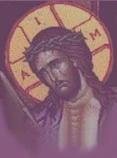|

[Comment]
add your
site
click
here to help ginkworld with a $10.00 donation
|
ON.THEOLOGY
The Messy Church on Mission at the Manger
by
doug jackson
second
baptist church
www.2bc.org
Michael Womack, a member of 2BC and a mainstay of the church choir, makes
his living as a horticulturist. Part of his job involves writing a weekly
column for the local paper, in which he talks about the care and feeding of
various types of plants. A recent screed turned topical for the holidays,
giving insights into the poinsettia plant. Michael gave two explanations of
the Christmas flower’s rosy hue.
Theory number one goes like this: a poor Mexican girl named Pepita wanted
to attend Christmas eve services at her village church, but grieved that she
had no gift to place before the Christ-child. Her cousin, Pedro, attempted to
buck her up with the argument that even the humblest offering would be
acceptable to El Nino. Accordingly, Pepita stooped beside the path that lead
to the chapel and harvested a handful of weeds. When she dumped this noxious
bouquet before the manger, it burst into flaming crimson blossoms, showing
that Jesus had indeed valued her gift by its intent rather than its market
value, and that is why poinsettias bloom in mid-winter and are dubbed Las
Flores de Buena Nocha, the Flowers of the Holy Night.
The alternative account runs something like this: poinsettias are
photoperiodic, blooming in response to the short days and long nights of
winter. What we call "flowers" are actually bracts,
specialized leaves designed to attract pollenating bugs to the dowdy yellow
blossoms, or cyathia, in the center.
Now, my question is not which explanation is correct, but which is true.
Or, to put it another way, which do you like better? One is factually
verifiable and accounts for certain physical phenomena. The other is almost
certainly legendary and tells us something true about Jesus. I think Michael
sums up nicely when he ends his article by saying, "The poinsettia is an
easy plant to grow. It’s brilliant red bracts will fill your home with color
and stories."
Color and stories: far better things to have at Christmas (or any other
time) than data about buds and bracts. And it is the story that reminds me of
another story, one that is factual but whose truth outweighs its historicity.
Three wise men appeared at Jesus’ home and left gold, frankincense and
myrrh. Of course, these are much higher-ticket items than roadside crabgrass,
but I see the justice of Frederick Buechner’s comment, "The gifts the
three Wise Men, or Kings, or Magi, brought to the manger in Bethlehem cost
them plenty but seem hardly appropriate to the occasion. Maybe they were all
they could think of for the child who had everything."
Inappropriate gifts: what, after all, does an infant do with metal and
perfume? Superfluous gifts: what, after all, does the Son of God really need?
Yet acceptable gifts, and for the same reason as Pepita’s dandelions: they
represented a desire to honor the Savior.
As we light the Wise Men’s candle this Sunday, and read once again the
account of their trek to Palestine, be reminded that what really matters is
not what we give, but that we give; not what we do for Jesus, but what he does
with what we’ve done.
Doug
|